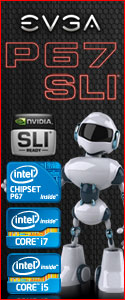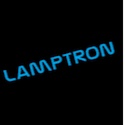Once past the packaging and accessories we get to the crux of the of this review, the motherboard itself. The motherboard comes packaged in EVGA’s standard antistatic bag with the pink antistatic pad beneath.
Here at Overclockers Tech, it’s a must to remove the stock heatsinks and have a look “under the hood” so to speak. Once removed from the antistatic bag, the heatsinks covering the H55 chipset and the PWM area were removed to reveal the factory application of thermal interface material. They did a terrific job applying TIM to the H55 chip, just the right amount. The PWM heatsink uses a thermal pad that runs the length of the apparatus. As you can see by the picture below, there is good contact with the PWM chips which should allow them to run relatively cool. All in all a terrific job applying thermal material on both areas. How will the heatsinks perform temperature wise? We’ll find out soon enough when we put the motherboard through it’s paces. Below are a few pictures of the heatsinks as they were removed from the motherboard.
 |
 |
Next we take a tour of the EVGA H55 motherboard with some up close pictures of the different areas. First up is the bottom of the motherboard where you will find such items as the built in speaker, on-board reset and power buttons, the clear CMOS button, two 3-pin fan headers, and the three PCI slots. You can also see the AMI BIOS chip which is not removable, so forget about swapping a BIOS chip should you ever encounter a bad BIOS flash. Further to the bottom right of the motherboard you will find the on-board Firewire header, two USB headers, the case front panel connections and the two JMB363 Sata ports. You can also see the battery holder and the LED post code display.
 |
 |
The next area to explore is the right side of the EVGA H55. This is where you will find the IDE controller, the six Intel SATA ports, and the 24-pin main power connector. You can also see the H55 chipset heatsink and the DIMM slots with the attached sticker that explains the proper way to install your memory modules.
 |
 |
As we work our way around to the top of the board, we get a good look at the voltage readout points that are built in on-board. The voltage readout points are very popular with the overclocking crowd and can also aid in troubleshooting if needed. It seems EVGA is applying these voltage readout points to just about every level of motherboard they produce nowadays, it’s a fantastic feature! You will also see three more fan headers, one for the CPU and the other two for additional system fans. All totaled there are six fan headers on the EVGA H55, quite impressive. Also note the placement of the 8-Pin 12v CPU plug, exactly where we like to see them – on the edge of the motherboard. And finally we have a good view of the PWM heatsink
 |
 |
Continuing on, we arrive at the left side of the board and the I/O area. There are no less than eight USB ports located here along with a firewire connection as well. Also included in the I/O area are the three different video connections which include D-Sub, DVI, and the Display Port. Furthermore, there is a LAN and P/S2 keyboard connection available. Take note there is no PS/2 mouse port available. Moving further toward the bottom of the left side of the motherboard  you will see the two PCI-e slots. The upper-most PCI-e slot is X16 and the lower slot is X4. You may notice the lack of any PCI-e X1 slots, the option for them is obviously available as all the weld points are present on the PCB. EVGA chose to omit the PCI-e X1 slots from this offering. EVGA’s H57 version does implement both of the PCI-e X1 slots.
 |
 |
No motherboard tour would be complete without a few full board shots. Just a couple of things of note here, first notice that the CPU socket area is drilled with mounting holes for both socket 1156 and socket 775 coolers. If you are upgrading from a socket 775 platform to this EVGA H55 then you need not purchase a new CPU cooler. There is just one minor caveat. Any socket 775 cooler attached will fit slightly off kilter and give the appearance of a slight twist. This does not impact the performance of the socket 775 cooler. Although the bolt pattern of the socket 1156 is bigger than that of the socket 775, the difference is so minor that you can not simply drill the socket 775 holes inline with the socket 1156 holes, there is not enough room. The only way to implement this design is by doing it exactly like EVGA has done it here. A slightly twisted appearance to your CPU cooler is a small price to pay for the money saved using your existing cooler. This really is another great feature! Also worth noting is a 4-fold leaflet attached to the CPU socket. As you unfold the four pages you see the four steps to proper CPU installation, another nice touch.
 |
 |


 Posted in
Posted in 



